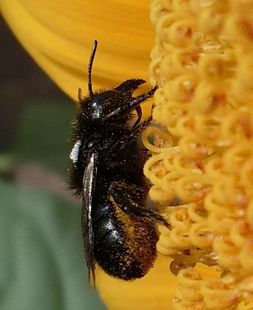Pollen carryover between sequential foraging trips by a solitary bee: Implications for distant outcrossing
DOI:
https://doi.org/10.26786/1920-7603(2018)15Abstract
Animal pollination depends on foragers moving pollen between conspecific flowers and plants. Pollinating bees often exhibit patch fidelity and frequent grooming during a foraging trip, which results in intensely localized pollen carryover. If their host’s seed dispersal is likewise limited, then spatial mosaics of small genetic neighbourhoods should result. However, spatial distributions of genetic markers of seeds often reveal infrequent long-distance gene flow mediated by pollinating bees, seemingly at odds with expectations of bees’ local patch fidelity and suggesting an additional mechanism at work.
A greenhouse experiment that used nesting Osmia californica bees foraging at sunflowers tested the pollination fate of any bodily pollen that lingers on females even after they discharge a pollen load at their nest. Once a provisioning female had returned to her nest, we moved the nest with her inside from a cage with male-fertile sunflowers to a cage with male-sterile sunflowers. There females quickly resumed foraging. They nearly always pollinated and set seed at the first male-sterile flowerhead that they visited, the result of fertile bodily pollen carried over from the previous foraging trip. Every visit to a second male-sterile flowerhead set additional seed.
If, as seems likely, outbound nesting females sometimes switch between host patches, then this mechanism of pollen carryover could explain occasional distant pollen-mediated gene flow events, as summarizes in a graphic model. Carryover should mitigate inbreeding depression in threatened plant populations, or conversely, sometimes contaminate seed crops, with relevance for spatially isolating foundation seed fields and coexistence of GMO and conventional crops.
Downloads
Published
How to Cite
Issue
Section
License
Copyright (c) 2019 James H Cane, Byron Love

This work is licensed under a Creative Commons Attribution 4.0 International License.
JPE is an open access journal which means that all content is freely available without charge to the user or his/her institution.
Authors who publish with this journal agree to the following terms:
1) Authors retain copyright and grant the journal right of first publication with the work simultaneously licensed under a Creative Commons Attribution License that allows others to share the work with an acknowledgement of the work's authorship and initial publication in this journal.
2) Authors are able to enter into separate, additional contractual arrangements for the non-exclusive distribution of the journal's published version of the work (e.g., post it to an institutional repository or publish it in a book), with an acknowledgement of its initial publication in this journal.
3) Authors are permitted and encouraged to post their work online (e.g., in institutional repositories or on their website) prior to and during the submission process, as it can lead to productive exchanges, as well as earlier and greater citation of published work (See The Effect of Open Access).
To assure a broader targeted audience, content will be included into databases (such as EBSCO) and directories (such as DOAJ).











